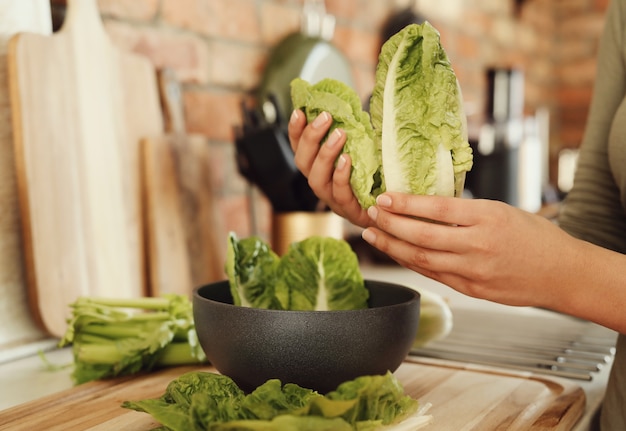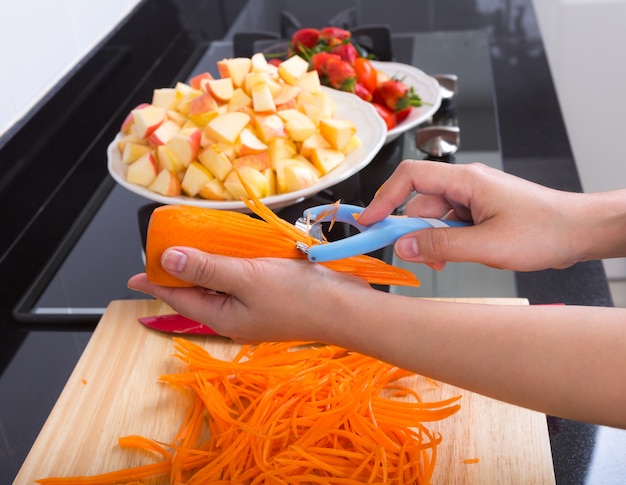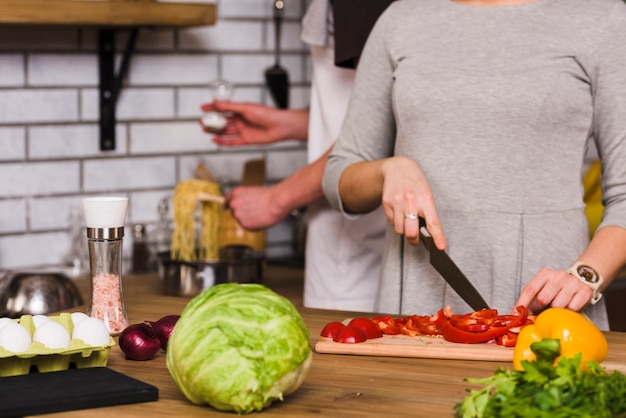Cabbage. A humble vegetable, often relegated to the sidelines of the culinary world. But trust me, there's a world of flavour and versatility waiting to be discovered in this unassuming head of leaves. From hearty stews to crisp salads, cabbage can be a star ingredient, and it all starts with mastering the art of cooking it perfectly.
Over the years, I've learned a thing or two about cooking cabbage. I've made my fair share of mistakes - soggy, mushy cabbage, anyone? - but I've also found the secrets to achieving that perfect texture: tender but not mushy, with a hint of sweetness and a depth of flavour that makes you want to sing its praises.
So, grab your trusty pan and let's embark on this culinary journey together. We'll explore the different ways to cook cabbage on the stovetop, unravel the mysteries of achieving the perfect cooking time, and delve into some mouthwatering recipe ideas. Buckle up, my friend, because we're about to unleash the magic of cabbage!
(Part 1) The Secrets of Cooking Cabbage: A Culinary Journey

Before we dive into specific methods, let's talk about the fundamental principles of cooking cabbage. It's not rocket science, but there are a few key things to keep in mind to ensure success.
Choosing the Right Cabbage: A Matter of Taste
Just like choosing the right wine for a meal, picking the right cabbage is crucial. For a classic boiled cabbage, you want a firm head with crisp leaves. Look for a vibrant green colour and avoid any with brown spots or soft, mushy leaves. This indicates it's past its prime and won't cook up as well.
For other cooking methods, like stir-frying or braising, consider using a more tender cabbage variety like Napa or Savoy. These have thinner leaves that cook faster and hold their shape better, making them ideal for dishes that require a more delicate texture.
Preparing the Cabbage: The First Step to Success
Once you've got your perfect cabbage, it's time to give it a good wash and trim off any damaged or wilted leaves. For a boiled cabbage, you'll want to cut it into wedges or quarters, depending on its size. For stir-frying, shred it thinly.
And here's a little tip that makes a big difference: always trim the core of the cabbage. This tough, woody centre won't cook properly and can make your final dish unpleasant.
The Magic of Salt: Unveiling Hidden Flavours
Now, here's a secret that elevates the flavour of your cabbage: salt! Adding salt to the cooking water does more than just enhance flavour - it helps draw out the cabbage's natural sweetness and also encourages more even cooking. This is especially helpful when boiling cabbage, as it ensures that each part of the cabbage cooks at the same rate.
Time is of the Essence: Finding the Perfect Balance
This is where it gets tricky. The cooking time for cabbage depends on the method you're using and the desired texture. Too short, and you'll end up with crunchy, raw cabbage. Too long, and you'll have a mushy, sad mess.
Don't worry, we'll delve into specific cooking times for different methods in the next sections. But remember, these are just guidelines. The actual time will vary depending on the size and thickness of the cabbage, the heat of your stovetop, and your desired level of doneness.
The key is to keep an eye on the cabbage and check its progress regularly. You can test it by piercing it with a fork or knife. If it offers resistance, it needs more time. If it's soft and mushy, it's overcooked.
(Part 2) Boiled Cabbage: A Classic comfort food

Ah, boiled cabbage. It might not sound fancy, but it's a comforting classic that evokes memories of childhood dinners and hearty family meals. It's the perfect side dish for roast dinners, and it can be a delicious base for other dishes like coleslaw or salads.
The Key to Perfect Boiled Cabbage: The Art of Timing
The trick to perfect boiled cabbage is to cook it until it's tender but still has a slight bite. You don't want it to be mushy. It should have a satisfyingly tender texture that melts in your mouth but still retains a touch of crispness. Here's a step-by-step guide to achieving boiled cabbage perfection:
- Fill a large pot with water and bring it to a rolling boil.
- Add a generous pinch of salt to the boiling water. Remember, we're trying to draw out the cabbage's natural sweetness.
- Cut the cabbage into wedges or quarters, depending on its size. You can also cut it into smaller pieces if you prefer.
- Add the cabbage to the boiling water and reduce the heat to a simmer. A simmering temperature ensures the cabbage cooks gently and evenly, preventing it from becoming overcooked.
- Cover the pot and let the cabbage simmer for 15-20 minutes, or until tender. This is where your patience comes in. Resist the urge to peek too often!
- Test the cabbage by piercing it with a fork. It should be tender but still have a slight resistance. If it gives way easily, it's overcooked.
- Drain the cabbage and serve it with a knob of butter or a drizzle of olive oil. The butter or olive oil adds a touch of richness and enhances the flavour.
For a more flavourful boiled cabbage, consider adding other ingredients. A bay leaf, a few peppercorns, or a sprig of thyme will give it a more complex aroma. You can also add a tablespoon of vinegar to the water for a slightly tangy flavour, which is a wonderful contrast to the cabbage's sweetness.
(Part 3) braised cabbage: Slow and Delicious

If you're looking for a more flavourful and tender cabbage, braising is the way to go. It's a slow and gentle cooking method that allows the cabbage to absorb all the delicious flavours of the braising liquid. This results in a deeply flavorful cabbage that's both tender and satisfying.
Braising Essentials: The Key Ingredients
Here's what you'll need to braise your cabbage to culinary perfection:
- A large, heavy-bottomed pot or dutch oven. This type of pot is essential for braising as it retains heat evenly and prevents scorching.
- Some fat, like bacon fat, olive oil, or butter. The fat helps to create a rich flavour base and prevents the cabbage from sticking to the pot.
- Aromatics like onions, carrots, or celery. These add a layer of sweetness and depth to the flavour of the dish.
- A flavorful braising liquid, like broth, wine, or beer. The liquid infuses the cabbage with flavour and creates a luscious sauce.
- Seasonings like salt, pepper, herbs, and spices. These enhance the natural flavours of the cabbage and add a personalized touch to your dish.
Braising Steps: A Culinary Symphony
Here's how to braise cabbage to perfection, a method that takes time but yields incredible results:
- Sauté the aromatics in the fat until softened. This is the foundation of the flavour of your braised cabbage. Don't be afraid to let the aromatics caramelize slightly for a deeper flavour.
- Add the chopped cabbage and cook for a few minutes, until slightly softened. This step helps to draw out some of the cabbage's moisture and creates a more tender texture.
- Pour in the braising liquid, season generously, and bring to a simmer. A gentle simmer allows the cabbage to cook slowly and absorb all the flavours of the braising liquid.
- Cover the pot and braise the cabbage for 30-45 minutes, or until tender. The braising time will vary depending on the thickness of the cabbage and your desired texture. Check it regularly by piercing it with a fork to ensure it's tender but not mushy.
You can adjust the braising time depending on the thickness of the cabbage and your desired texture. If you prefer a more robust texture, you can braise it for a shorter period of time. For a melt-in-your-mouth experience, braise it for a longer time.
(Part 4) stir-fried cabbage: Quick and Easy
For a quick and easy weeknight meal, stir-fried cabbage is the perfect solution. It's packed with flavour and takes just minutes to cook, making it ideal when you're short on time but don't want to compromise on flavour.
The Stir-Fry Method: A Culinary Whirlwind
Here's how to stir-fry cabbage like a pro, a technique that involves quick cooking over high heat:
- Heat a large wok or frying pan over high heat. A hot pan is essential for stir-frying as it allows the cabbage to cook quickly and evenly.
- Add a tablespoon of oil to the pan. The oil prevents the cabbage from sticking to the pan and adds a touch of richness to the dish.
- Add the shredded cabbage to the hot pan and stir-fry for 2-3 minutes, until slightly softened but still with a slight crunch. The goal is to cook the cabbage quickly without losing its texture.
- Season with salt, pepper, and any other desired spices or sauces. A simple seasoning of salt and pepper is often all you need, but feel free to experiment with other flavours.
You can add other ingredients to your stir-fried cabbage to elevate its flavour and create a more substantial meal. Garlic, ginger, onions, mushrooms, or tofu are all excellent additions. Just make sure to add them in the last minute of cooking so they don't overcook.
(Part 5) Cabbage Cooking Times: A Handy Guide
Now, let's get down to the nitty-gritty of cooking times. As I mentioned earlier, these are just guidelines. The actual time will vary depending on the size and thickness of the cabbage, the heat of your stovetop, and your desired level of doneness.
It's always best to check the cabbage periodically by piercing it with a fork or knife. If it offers resistance, it needs more time. If it's soft and mushy, it's overcooked.
Cabbage Cooking Times: A Quick Reference
Here's a handy guide for different cabbage cooking methods:
| Cooking Method | Cooking Time |
|---|---|
| Boiled | 15-20 minutes |
| Braised | 30-45 minutes |
| Stir-fried | 2-3 minutes |
Remember, these are just starting points. Adjust the cooking time as needed to achieve your desired level of doneness. Trust your instincts and don't be afraid to experiment.
(Part 6) cabbage recipes: Unleash Your Creativity
Now that you know the basics of cooking cabbage, it's time to get creative in the kitchen. Here are a few recipe ideas to get you started, exploring both classic and modern interpretations of this versatile vegetable.
Classic cabbage dishes: Timeless Delights
- Coleslaw: This classic side dish is a perfect way to showcase the freshness and crunch of cabbage. It's simple to make and always a crowd-pleaser. Try adding a tangy twist with a homemade vinaigrette or experiment with different seasonings like caraway seeds or dill.
- cabbage rolls: These are a hearty and comforting dish, often filled with meat, rice, and vegetables. Cabbage rolls are a quintessential comfort food, perfect for a cold winter evening. Get creative with your fillings and try using different grains like quinoa or farro for a modern twist.
- Sauerkraut: This fermented cabbage is a staple in German cuisine and adds a tangy and flavorful element to many dishes. Sauerkraut is a testament to the power of fermentation. Its tangy flavour enhances dishes like sausages and pork roasts. Try using it in a modern twist on a classic dish like sauerkraut and apple pancakes.
Modern Cabbage Dishes: Fresh and Innovative
- Cabbage Salad with Sesame Dressing: This fresh and vibrant salad is a delicious and healthy option. The sesame dressing adds a nutty and savory flavour that complements the cabbage's sweetness.
- Crispy Cabbage Stir-fry with Ginger and Garlic: This is a quick and flavorful dish that's perfect for a busy weeknight. The ginger and garlic add a spicy and aromatic element to the stir-fry, while the cabbage provides a healthy crunch.
- Braised Cabbage with Apples and Bacon: This sweet and savory dish is perfect for a cozy dinner. The apples add a touch of sweetness and the bacon adds a smoky depth of flavour, creating a truly comforting dish.
(Part 7) Don't Throw Away the Leftovers!
Don't be quick to toss out those leftover cabbage bits! They can be used in all sorts of delicious ways. Leftover cabbage is a culinary treasure, offering a blank canvas for creativity.
Here are a few ideas to make the most of your cabbage leftovers:
- Add it to soups or stews: A handful of chopped leftover cabbage can add texture and flavour to your favourite soups and stews. It adds a touch of sweetness and a satisfying crunch to hearty dishes.
- Make a cabbage frittata or omelet: Leftover cabbage adds a delicious crunch to a frittata or omelet. It's a great way to use up leftover cabbage and add a touch of freshness and flavour to a classic breakfast dish.
- Use it in sandwiches or wraps: A few leaves of cabbage can be used as a base for sandwiches or wraps, adding a fresh and healthy element. It's a delicious and nutritious alternative to lettuce, offering a satisfying crunch and a slightly bitter note.
- Make a cabbage slaw: Combine leftover cabbage with mayonnaise, vinegar, and your favourite spices to create a delicious slaw. It's a simple and versatile side dish that's perfect for barbecues, picnics, or even as a topping for burgers or tacos.
(Part 8) FAQs about Cabbage Cooking: Unveiling the Mysteries
Here are some frequently asked questions about cooking cabbage, addressing common concerns and providing insightful answers.
Q: What are the best ways to store cabbage?
A: Store cabbage in the refrigerator, wrapped in plastic wrap or in a resealable bag. This helps to prevent it from drying out and wilting. It can last for about a week if stored properly.
Q: Can I cook cabbage in the microwave?
A: Yes, you can cook cabbage in the microwave. Microwave it for 3-5 minutes, or until tender. However, microwaving often results in a less flavorful and slightly soggy cabbage. It's a good option for a quick fix, but if you have time, other methods will result in better flavour and texture.
Q: What are some tips for making cabbage more flavorful?
A: Try adding some acid, like vinegar or lemon juice, to the cooking water. This helps to brighten the flavour and prevent the cabbage from becoming overly sweet. You can also add herbs, spices, or aromatics, like onions, garlic, or ginger. These ingredients enhance the natural flavour of the cabbage and create a more complex flavour profile.
Q: What are the health benefits of cabbage?
A: Cabbage is a nutritional powerhouse! It's a great source of vitamins, minerals, and antioxidants. It is also low in calories and fat, making it a healthy addition to any diet. It's a good source of vitamin C, vitamin K, and fibre, and it's also a good source of antioxidants, which can help to protect your cells from damage.
Q: What are some other varieties of cabbage?
A: Besides the common green cabbage, there are many other varieties, each with its own unique flavour and texture. Here are some of the most popular varieties:
- Red Cabbage: This vibrant red cabbage has a slightly sweet and tangy flavour and is often used in salads or cooked down for a rich and colourful side dish.
- Savoy Cabbage: This delicate cabbage has frilly leaves and a slightly nutty flavour. It's great for braising or stir-frying as it retains its texture well.
- Napa Cabbage: This Asian cabbage has long, tender leaves and a slightly sweet and peppery flavour. It's often used in stir-fries and salads.
- Bok Choy: This leafy green vegetable has a crisp texture and a slightly sweet and peppery flavour. It's a popular ingredient in Asian cuisine and is often stir-fried or braised.
So, there you have it. Embrace the humble cabbage, and discover its versatility in your own kitchen! With a little bit of knowledge and a dash of creativity, you can cook cabbage to perfection and enjoy its unique flavour and texture in countless delicious dishes. Happy cooking!
Everyone is watching

How to Cook Frozen Lobster Tails Perfectly: A Step-by-Step Guide
RecipesLobster. Just the word conjures up images of lavish meals, special occasions, and a taste of luxury. But let's...

Pigs in a Blanket Cooking Time: How Long to Bake for Perfect Results
RecipesAh, pigs in a blanket. Just the name conjures up images of those delightful little parcels of crispy pastry en...

Pork Fillet Cooking Time: How Long to Cook It Perfectly
RecipesPork fillet, or tenderloin as it's sometimes called, is a real favourite in our house. It's so versatile, and...

The Ultimate Guide to Cooking Sweet Potatoes: From Roasting to Mashing
RecipesSweet potatoes. Just the name conjures up images of warm, comforting dishes, bursts of vibrant color, and a to...

The Ultimate Guide to Tender, Juicy Pulled Pork
RecipesRight, let's talk pulled pork. It's one of those dishes that just screams "comfort food," doesn't it? I mean...
